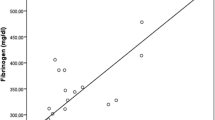Abstract
Objective: We previously demon-strated that patients suffering from moderate hypothyroidism were at increased risk of thrombosis contrasting with the bleeding tendency of those presenting severe hypothyroidism. The latter state is associated with hemostatic anomalies including von Willebrand type 1 disease and increased fibrinolytic capacity. With the exception of von Willebrand type 1 disease, reversibility of hemostatic changes is not established after levothyroxine replacement therapy. Therefore our objective was to analyze the reversibility of these anomalies. Materials and Methods: We analyzed the impact of levothyroxine treatment on lipid parameters, fibrinogen, platelet count, D-dimers, α2 antiplasmin activity, plasminogen activity, tissue plasminogen activator antigen (t-PA Ag), plasminogen activator inhibitor type 1 antigen (PAI-1 Ag) and coagulation factors (factor VIII coagulant, von Willebrand factor antigen, von Willebrand factor and factor IX) in 23 patients with severe hypothyroidism (TSH level >50 mU/l). Results: Mean fibrinogen levels increased by 14.2% while t-PA Ag and PAI-1 Ag increased by 42.6 and 69%, respectively, after correction of hypothyroidism. Interestingly, post-treatment PAI-1 Ag levels tended to be higher in patients with normal-high final TSH levels than in patients with normal-low final TSH levels. Our results suggest that normalization of fibrinolysis is obtained after a transient decrease of fibrinolytic activity. We also confirmed the correction of coagulation factor abnormalities upon levothyroxine replacement therapy. Conclusions: We demonstrated that the coagulation disorders and the hyperfibrinolytic status of severe hypothyroid patients were corrected upon levothyroxine therapy. However, the clinical consequences of the transient decrease of the fibrinolytic activity during the course of TSH normalization need further studies.
Similar content being viewed by others
References
Canaris GJ, Manowitz NR, Mayor G, Ridgway EC. The Colorado thyroid disease prevalence study. Arch Intern Med 2000, 160: 526–34.
Becker C. Hypothyroidism and atherosclerotic heart disease: pathogenesis, medical management, and the role of coronary artery bypass surgery. Endocr Rev 1985, 6: 432–40.
Perk M, O’Neill BJ. The effect of thyroid hormone therapy on angiographic coronary artery disease progression. Canadian J Cardiol 1997, 13: 273–6.
Gomberg-Maitland M, Frishman W. Thyroid hormone and cardiovascular disease. Am Heart J 1998, 135: 187–96.
Giannattasio C, Rivolta MR, Failla M, Mangoni AA, Stella ML, Mancia G. Large and medium sized artery abnormalities in untreated and treated hypothyroidism. Eur Heart J 1997, 18: 1492–8.
Willeit J, Kiechl S, Oberhollenzer F, et al. Distinct risk profiles of early and advanced atherosclerosis. Prospective results from the Bruneck study. Arterioscler Thromb Vasc Biol 2000, 20: 529–37.
Bruckert E, Giral P, Chadarevian R, Turpin G. Low free-thyroxine are a risk factor for subclinical atherosclerosis in euthyroid hyperlipidemic patients. J Cardiovasc Risk 1999 6: 327–31.
Hak AE, Pols HAP, Visser TJ, Drexhage HA, Hofman A, Witteman JCM. Subclinical hypothyroidism is an independent risk factor for atherosclerosis and myocardial infarction in elderly women: The Rotterdam Study. Ann Intern Med 2000, 132: 270–8.
Hofbauer LC, Heufelder AE. Coagulation disorders in thyroid diseases. Eur J Endocrinol 1997, 136: 1–7.
Ford HC, Carter JM. Haemostasis in hypothyroidism. Postgrad Med J 1990, 66: 280–4.
Farid NR, Griffiths BL, Collins JR, Marshall WH, Ingram DW. Blood coagulation and fibrinolysis in thyroid disease. Thromb Haemost 1976, 35: 415–22.
Levesque H, Borg JY, Cailleux N, et al. Acquired von Willebrand’s syndrome associated with decrease of plasminogen activator and its inhibitor during hypothyroidism. Eur J Med 1993, 2: 287–8.
Chadarevian R, Bruckert E, Leenhardt L, Giral P, Ankri A, Turpin G. Components of the fibrinolytic system are differently altered in moderate and severe hypothyroidism. J Clin Endocrinol Metab 2001, 86: 732–7.
Michiels JJ, Budde U, van der Planken M, van Vliet HH, Schroyens W, Berneman Z. Acquired von Willebrand syndromes: clinical features, aetiology, pathophysiology, classification and management. Best Pract Res Clin Haematol 2001, 14: 401–36.
Tanis BC, Westendorp GJ, Smelt HM. Effect of thyroid substitution on hypercholesterolaemia in patients with subclinical hypothyroidism: a reanalysis of intervention studies. Clin Endocrinol (Oxf) 1996, 44: 643–9.
Krassas GE, Pontikides N, Kaltsas T, et al. Disturbances of menstruation in hypothyroidism. Clin Endocrinol (Oxf) 1999, 50: 655–9.
Chadarevian R, Bruckert E, Giral P, Turpin G. Relationship between thyroid hormones and fibrinogen levels. Blood Coag Fibrinol 1999, 10: 481–6.
Chadarevian R, Bruckert E, Ankri A, Beucler I, Giral P, Turpin G. Relationship between thyroid hormones and plasma D-dimer levels. Thromb Haemost 1998, 79: 99–103.
Thogersen AM, Jansson JH, Boman K, et al. High plasminogen activator inhibitor and tissue plasminogen activator levels in plasma precede a first acute myocardial infarction in both men and women: evidence for the fibrinolytic system as an independent primary risk factor. Circulation 1998, 98: 2241–7.
Held C, Hjemdahl P, Rehnqvist N, et al. Haemostatic markers, inflammatory parameters and lipids in male and female patients in the Angina Prognosis Study in Stockholm (APSIS). A comparison with healthy controls. J Intern Med 1997, 241: 59–69.
Cushman M, Lemaitre RN, Kuller LH, et al. Fibrinolytic activation markers predict myocardial infarction in the elderly. The Cardiovascular Health Study. Arterioscler Thromb Vasc Biol 1999, 19: 493–8.
Kohno A, Hara Y. Severe myocardial ischemia following hormone replacement in two cases of hypothyroidism with normal coronary arteriogram. Endocr J 2001, 48: 565–72.
Bunevicius R, Kazanavicius G, Zalinkevicius R, Prange AJ Jr. Effects of thyroxine as compared with thyroxine plus triiodothyronine in patients with hypothyroidism. N Engl J Med 1999, 340: 424–9.
Escobar-Morreale HF, Obregon MJ, Escobar del Rey F, Morreale de Escobar G. Replacement therapy for hypothyroidism with thyroxine alone does not ensure euthyroidism in all tissues, as studied in thyroidectomized rats. J Clin Invest 1995, 96: 2828–38.
Author information
Authors and Affiliations
Corresponding author
Rights and permissions
About this article
Cite this article
Chadarevian, R., Jublanc, C., Bruckert, E. et al. Effect of levothyroxine replacement therapy on coagulation and fibrinolysis in severe hypothyroidism. J Endocrinol Invest 28, 398–404 (2005). https://doi.org/10.1007/BF03347217
Accepted:
Published:
Issue Date:
DOI: https://doi.org/10.1007/BF03347217




